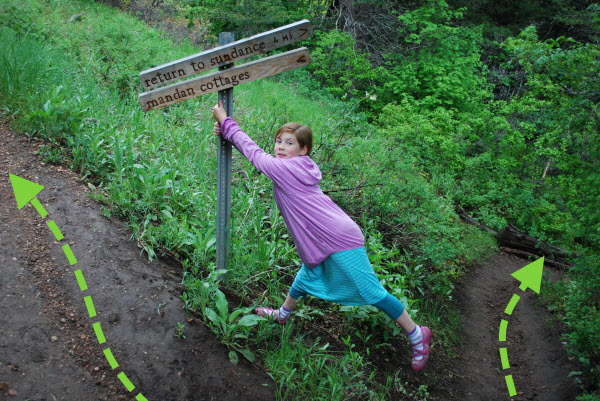Designing from the Content/Story Out
My wife Jane attended a Segullah writer's retreat conference this weekend. During the conference, one of the presenters explained a common mistake many novice writers make: they look for stories to fit a pre-selected theme.
You hear the result of this strategy most commonly in church talks. Someone is assigned a topic, or has a topic he or she wants to explore. To make the talk/presentation/essay appealing, he or she looks for stories to fit the theme. The result is that each story is moralistic, simplified, and often distorted to fit the speaker's purpose.
A better approach is to start from the story and see what theme it moves towards. In other words, follow the story to whatever theme/meaning it naturally leads you to, rather than trying to fit it into a pre-selected theme. Even if you want to take one path (in the photo below, for example, Mandan Cottages), if the story naturally pushes you toward another path (for example, Return to Sundance), go with the natural path of the story.
It's excellent advice, but not just for writers. The advice is a cousin to the commonly heard UX principle of "designing from content outward." It's the same idea that people who wear shirts with a big red x through the words "Lorem Ipsum" are trying to get across. Start with the content first and then create a design for it. Otherwise your design won't fit the content.
In a writeup on the SXSW 2010 conference, Adam Schwabe explains the importance of starting with content first. He says,
Content is all too often considered as an afterthought after wireframes and design comps have been presented to and approved by the client. Relegated to boxes as placeholders and Lorem Ipsum, too many of us take a “do it later” approach with what is most important to the user. People aren't visiting your site to look at colours and boxes, they're there for a purpose, and the content should be at the core of any design. (SXSW 2010: Trends and Highlights)
Just as writers start from story and build meaning from those events, user experience professionals start with content and design the frame/layout for it. It seems obvious, but few follow this logic.
If you create a design that doesn't stem from the content, you end up with a mismatch. When it comes to add your content, you find that your content/story doesn't actually fit the design/theme.
About Tom Johnson

I'm an API technical writer based in the Seattle area. On this blog, I write about topics related to technical writing and communication — such as software documentation, API documentation, AI, information architecture, content strategy, writing processes, plain language, tech comm careers, and more. Check out my API documentation course if you're looking for more info about documenting APIs. Or see my posts on AI and AI course section for more on the latest in AI and tech comm.
If you're a technical writer and want to keep on top of the latest trends in the tech comm, be sure to subscribe to email updates below. You can also learn more about me or contact me. Finally, note that the opinions I express on my blog are my own points of view, not that of my employer.

